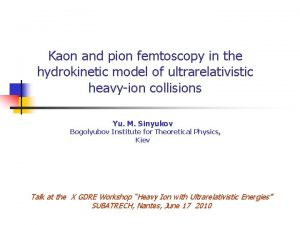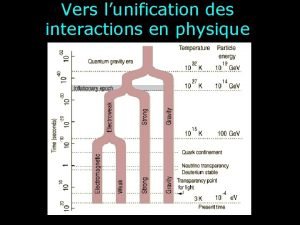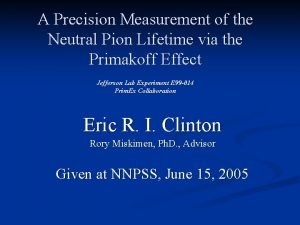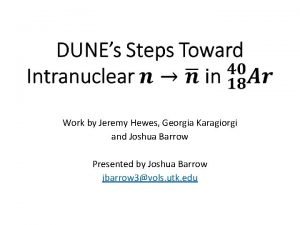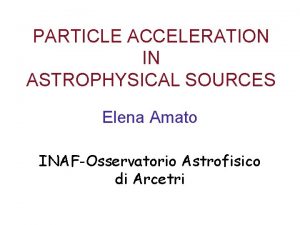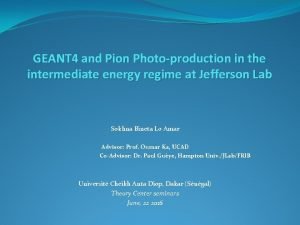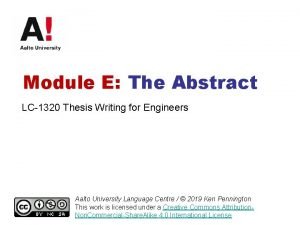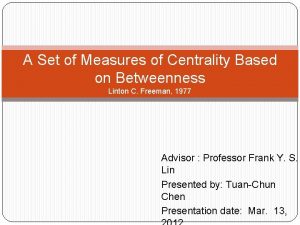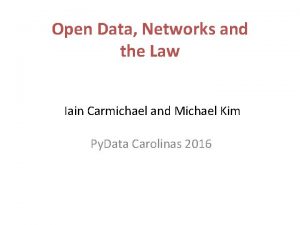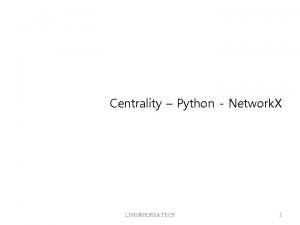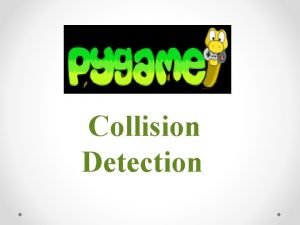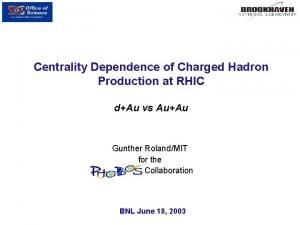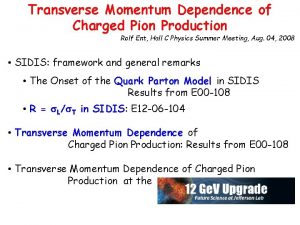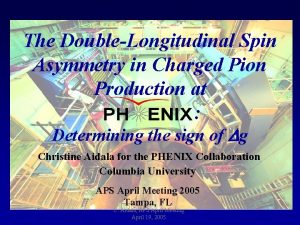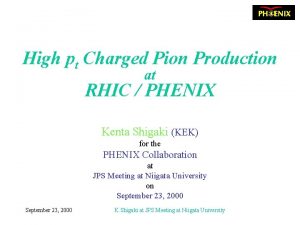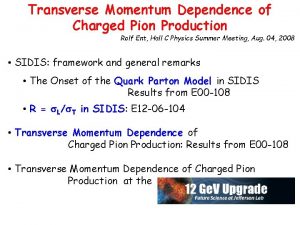Collision centrality dependencies of charged pion production in

















- Slides: 17

Collision centrality dependencies of charged pion production in 12 C+181 Ta collisions at 4. 2 A Ge. V/c Kanokova Shakhnoza, National University of Uzbekistan 2018, November 7 Tashkent

The relevance of research Most part of collision energy in relativistic nuclear collisions is spent on pion production. Therefore, investigation of the collision centrality and incident energy dependencies of the rapidity and transverse momentum distributions of pions is of importance to extract the valuable information on the dynamics of the hadron-nucleus and nucleus-nucleus collisions at high energies

The relevance of research The present work is devoted to investigation of the dependencies of the average kinematical characteristics of the charged pions on the collision centrality in 12 C+181 Ta collisions at 4. 2 Ge. V/c per nucleon.


12 C+181 Ta Selection of events by collision centrality • Peripheral collision • Central collisions • Semicentral collision where is the mean multiplicity per event of participant protons. the number of participant protons collision centrality was used to define the

Table 1. The fraction of events (α), the average number of participant protons (< >), the mean multiplicity per event of the charged pions (<n(π)>), the ratio R(π)=<n(π)>/< >, the average total energy (<Σi. Ei(π)>) (in Me. V) of the charged pions per collision event at various centralities in 12 C+181 Ta collisions at 4. 2 Ge. V/c per nucleon. Statistical errors are shown. Quantity Collision Centrality Peripheral Semicentral Central α, % 59 1 24 1 17 1 < > 5. 0 0. 1 19. 6 0. 2 33. 5 0. 3 <n(π−)> 1. 49 0. 04 5. 31 0. 09 7. 98 0. 13 <n(π+)> 1. 25 0. 03 4. 90 0. 10 7. 66 0. 15 R(π−) 0. 30 0. 04 0. 27 0. 03 0. 24 0. 05 R(π+) 0. 25 0. 02 0. 25 0. 06 0. 23 0. 08 <Σi. Ei(π−)> (in Me. V) 671 24 1 817 74 2 138 56 <Σi. Ei(π+)> (in Me. V) 490 12 1 870 33 2 845 44

We can estimate the expected ratio <n(π−)>/<n(π+)> in 12 C+181 Ta collision system, using the simple model, which assumes that the number of the produced positive and negative pions is proportional to the number of colliding (involved) protons and neutrons, respectively, and that, for simplicity, each involved nucleon of a projectile nucleus undergoes just a single collision with a nucleon of a target nucleus. The probability of a single neutron-neutron (neutron from projectile 12 C 6 with neutron from target 181 Ta 73) collision is W(nn) 0. 3 and that of a single proton-proton (proton from projectile 12 C with proton from target 181 Ta) collision is W(pp) 0. 2. Similarly, one can calculate the probabilities of a single proton-neutron and neutron-proton collisions equal to W(pn) 0. 3 and W(np) 0. 2, respectively.

The probability of a single nucleon-nucleon W(NN) collision is equal to 1 (W(NN)=W(nn)+W(pp)+W(pn)+W(np)=1). Using the above probabilities, one can estimate the ratio <n(π−)>/<n(π+)> in 12 C+181 Ta collision system as follows: The ratio <n(π−)>/<n(π+)> proved to be 1. 20 ± 0. 05, 1. 08 ± 0. 04, and 1. 04 ± 0. 03 in the peripheral, semicentral, and central 12 C+181 Ta collision events, respectively, decreasing noticeably with increasing the collision centrality.

Table 2. The average values and widths of the spectra of the full (P), transverse (Pt) and longitudinal (Pl) momenta (in Me. V/c) and emission angles (Ө) (in degrees) of the charged pions in the laboratory frame at various centralities in 12 C+181 Ta collisions at 4. 2 Ge. V/c per nucleon. Statistical errors are shown. Collision Centrality Quantity <Р> DP <Рl> DPl <Рt> DPt <Ө> DӨ Peripheral Semicentral Central π− π+ 550 11 476 11 443 7 474 8 362 6 462 7 489 15 459 16 395 10 420 11 326 10 399 9 440 11 343 11 325 7 315 8 220 6 276 7 493 12 472 17 417 10 423 12 345 10 391 10 223 4 240 5 218 3 272 4 210 3 290 4 176 5 192 5 164 4 218 6 162 4 242 6 43. 1 0. 8 51. 5 0. 8 51. 1 0. 6 55. 4 0. 7 60. 2 0. 7 60. 4 0. 7 35. 6 0. 7 35. 2 0. 6 36. 2 0. 5 35. 2 0. 5 38. 4 0. 4 36. 0 0. 6

Fig 1. The momentum distributions of the negative (a) and positive (b) pions in peripheral (open circles) and central (closed circles) 12 C+181 Ta collisions at 4. 2 Ge. V/c per nucleon in the laboratory frame. The distributions are normalized per one pion. Statistical errors are shown.

Fig. 2. The emission angle distributions of the negative (a) and positive (b) pions in peripheral (open circles) and central (closed circles) 12 C+181 Ta collisions at 4. 2 Ge. V/c per nucleon in the laboratory frame. The distributions are normalized per one pion. Statistical errors are shown.

Summary and Conclusions The collision centrality dependencies of the average experimental kinematical characteristics of the negative and positive pions, produced in 12 C+181 Ta collisions at 4. 2 A Ge. V/c, were investigated. We observed the significant increase of the mean multiplicities per event of both π− or π+ mesons with increasing the 12 C+181 Ta collision centrality. The mean multiplicity of the negative pions proved to be noticeably larger as compared to that of the positive pions in the analyzed three centrality groups of 12 C+181 Ta collisions. Using the simple model, we estimated the ratio <n(π−)>/<n(π+)> to be 1. 22 in 12 C+181 Ta collision system.

Summary and Conclusions (2) The suppression of the ratio <n(π−)>/<n(π+)> in the semicentral and central 12 C+181 Ta collision events as compared to the calculated model ratio <n(π−)>/<n(π+)> 1. 22 was observed. The ratio <n(π−)>/<n(π+)> proved to be 1. 20 ± 0. 05, 1. 08 ± 0. 04, and 1. 04 ± 0. 03 in the peripheral, semicentral, and central 12 C+181 Ta collision events, respectively, decreasing noticeably with increasing the collision centrality. We observed the clear differences between the emission angle distributions of the charged pions produced in the peripheral and central 12 C+181 Ta collisions at 4. 2 Ge. V/c per nucleon. The peripheral collisions were characterized by the distinct peaks for both π− or π+ mesons at the relatively small values of emission angle ( 20 -300) in the laboratory frame.

Summary and Conclusions (3) The fraction of the charged pions with the large momenta in the normalized full momentum distributions of the negative and positive pions decreased significantly with an increase in centrality of 12 C+181 Ta collisions at 4. 2 A Ge. V/c. The fraction of the charged pions with small emission angles decreased and that with the large emission angles increased significantly for both the negative and positive pions with increasing the 12 C+181 Ta collision centrality. The average values of the full momentum distributions and their widths for the charged pions decreased significantly with an increase in 12 C+181 Ta collision centrality.

Summary and Conclusions (4) The above observations confirm our finding that the number of the relatively slow charged pions produced in secondary interactions (rescatterings) on nucleons of target 181 Ta nuclei increases significantly with increasing the collision centrality, which results in an increase of the average emission angle of π+ and π− mesons. The results of the present work can be useful for analysis of the centrality dependence of the charged pion production in heavy ion collisions at high energies.

Thank you!

 Post production
Post production Pion
Pion Gdwf
Gdwf Louis pion montre
Louis pion montre Pion lifetime
Pion lifetime Georgia karagiorgi
Georgia karagiorgi Pion decay
Pion decay Pion geant
Pion geant Thesis statement example
Thesis statement example Ap human geography unit 3 vocab
Ap human geography unit 3 vocab A set of measures of centrality based on betweenness
A set of measures of centrality based on betweenness Pidiom
Pidiom Closeness centrality
Closeness centrality Principles of access cavity preparation
Principles of access cavity preparation Katz centrality networkx
Katz centrality networkx Degree centrality python
Degree centrality python Pagerank centrality
Pagerank centrality Degree centrality networkx
Degree centrality networkx

